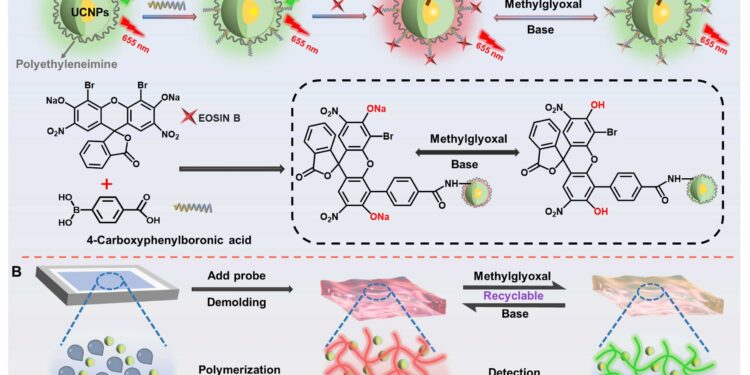Design and fabrication of the hydrogel sensing patch based on upconversion probes and its sensing response mechanism. Credit: Kang Xiaohui
A research team led by Professor Jiang Changlong from the Hefei Institutes of Physical Sciences of the Chinese Academy of Sciences has developed an innovative real-time multi-scenario fluorescence detection technology to monitor methylglyoxal.
The team designed and fabricated a sensor by integrating upconversion optical probes into three-dimensional porous hydrogels. This sensor, integrated with the color recognition capabilities of a smartphone, enables rapid, on-site detection of methylglyoxal.
“This means that in the future, your phone can help you preserve the flavor of your wine and keep an eye on your health,” said team member Kang Xiaohui. The results were published in Analytical chemistry.
Methylglyoxal is a dicarbonyl compound found in both wine fermentation and human metabolism. In wine, excess methylglyoxal can lead to off-flavors, such as astringency, while in humans, high concentrations are linked to an increased risk of diabetes. Therefore, developing reliable real-time methods to monitor its concentration is important for both wine quality and diabetes management.
Three-dimensional hydrogels are known for their extensibility and biocompatibility. However, many fluorescent hydrogels suffer from interference from autofluorescence and background, which limits their effectiveness in biological applications.
Reversible detection of methylglyoxal using the hydrogel detection patch. Credit: Kang Xiaohui
In this study, researchers used upconversion nanoparticles (UCNPs), which help eliminate background fluorescence interference and significantly improve detection sensitivity.
The hydrogel sensor developed by the research team is based on a probe composed of UCNP and modified eosin B (mEB), operating via a fluorescence resonance energy transfer (FRET) mechanism. When methylglyoxal interacts with mEB, the upconversion fluorescence changes from red to green, enabling precise detection.
The researchers embedded the probe in a hydrogel and used 3D printing technology to create a wearable, reversible fluorescent sensor.
The results demonstrated that the limits of detection (LOD) for the upconversion fluorescent probe and the hydrogel sensor were 59 nM and 75.4 nM, respectively.
This detection patch offers an innovative and effective solution for the standardization of aromas in wine production and for health monitoring of diabetic patients, according to the team.
More information:
Xiaohui Kang et al, Visual detection of methylglyoxal in multiple scenarios via a reversible NIR-Excitable ratiometric fluorescent hydrogel sensor, Analytical chemistry (2024). DOI: 10.1021/acs.analchem.4c05178
Provided by the Chinese Academy of Sciences
Quote: Real-time fluorescent sensor could enable precise monitoring of wine quality (January 14, 2025) retrieved January 14, 2025 from
This document is subject to copyright. Except for fair use for private study or research purposes, no part may be reproduced without written permission. The content is provided for informational purposes only.



